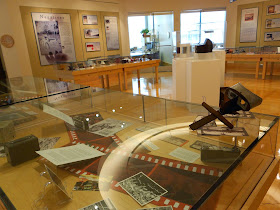Pages
▼
Tuesday, September 23, 2014
Janice Harrington Speaking Thursday
Professor Janice Harrington, storyteller, poet, and author of children’s books will speak this Thursday, September 25, at 7:00 p.m. in the Park Library Auditorium on the subject of children’s books and her own work.
Janice Harrington’s first children’s book, Going North, was published in 2004. The book won several awards and drew upon her memories of rural Lamar County, Alabama. The Chicken Chasing Queen of Lamar County, published in 2007, was one of Time magazine’s top ten children’s books of the year. Her 2008 book, Roberto Walks Home, continues the stories of Ezra Jack Keats, a now deceased white writer who was among the first to publish stories using African American and other children of color as central characters.
Currently a member of the faculty at the University of Illinois Urbana-Champaign, she was for seventeen years the head of children’s services at the Champaign Public Library. She has performed as a professional storyteller in a variety of settings, including the National Storytelling Festival in Washington, DC.
The presentation is free and open to the public. A reception will follow to talk in the Clarke Historical Library.
Professor Harrington’s presentation is made possible by the David M. and Eunice Sutherland Burgess Endowment.
Tuesday, September 16, 2014
New Exhibit Opening Thursday
The Clarke holds thousands of photographs in dozens of formats. Generally, these images are used to study a subject: a discussion of early lumbering in Michigan can be bolstered with a daguerreotype of a lumber baron, researchers studying Michigan Civil War soldiers will come across tintype portraits of servicemen, and the history of Central State Normal School (CMU's previous name) in the 1920s is brought to life with historic silver-gelatin prints.
 In the Clarke's new exhibit, Photography: Process, People, and Preservation, photographs are displayed and explained for their own sake, not the content or subject of the images. To guide visitors through the history of pre-digital photography, the exhibit explains the processes involved in producing photographs, from the toxic and labor intensive early days to the time when a roll of color film could be dropped off at a lab and picked up a few days later. The chemistry, the equipment required, and the challenges of producing a variety of photographs are explored.
In the Clarke's new exhibit, Photography: Process, People, and Preservation, photographs are displayed and explained for their own sake, not the content or subject of the images. To guide visitors through the history of pre-digital photography, the exhibit explains the processes involved in producing photographs, from the toxic and labor intensive early days to the time when a roll of color film could be dropped off at a lab and picked up a few days later. The chemistry, the equipment required, and the challenges of producing a variety of photographs are explored.In addition to the processes, the exhibit examines how photography played a role in the careers of various people, including an itinerant daguerreotypist, a commercial portrait photographer, and a team of university photographers. The exhibit also points out how photographs can be damaged and how they naturally deteriorate over time. Realizing the degradation of these images is essentially losing a piece of history can be discouraging, so the exhibit details the measures that museums, archives, libraries, and even individuals can take to preserve their images for generations to come.
 An exhibit on photography would not be complete without the tools used to produce photographs. Fortunately, the CMU Department of Art and Design is a wonderful resource for consulting on this subject, particularly Professor Al Wildey. He has loaned several of his historic cameras, some pieces of old photographing equipment, and many rare images that illustrate the processes explained in the exhibit.
An exhibit on photography would not be complete without the tools used to produce photographs. Fortunately, the CMU Department of Art and Design is a wonderful resource for consulting on this subject, particularly Professor Al Wildey. He has loaned several of his historic cameras, some pieces of old photographing equipment, and many rare images that illustrate the processes explained in the exhibit.Beyond consulting and loaning materials, Professor Wildey is also opening our exhibit with a presentation on Thursday, September 18 at 7:00 pm. He will discuss the history of photography before the digital age. The event takes place in the Park Library Auditorium followed by a reception in the Clarke to give attendees the chance to look at examples of the historical processes mentioned in the presentation.


